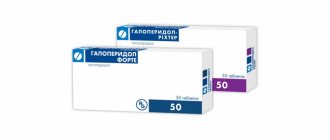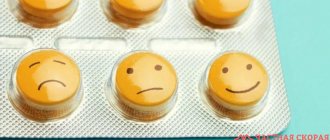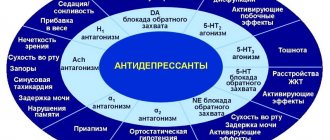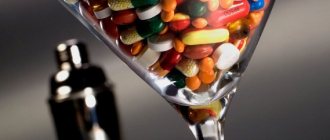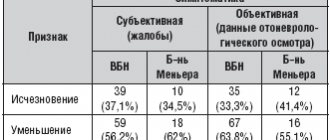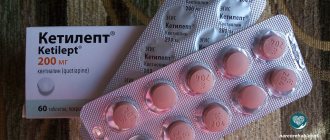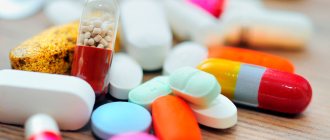Pharmacological properties
Pharmacodynamics.
Doxepin belongs to the group of tricyclic antidepressants. The antidepressant effect is combined with anxiolytic and sedative. Doxepin inhibits the reuptake of biogenic amines (norepinephrine and serotonin) in synaptic structures. It also has antihistamine, anticholinergic and α1-adrenergic blocking effects. Does not cause euphoria or psychomotor agitation.
Pharmacokinetics. Doxepin is well absorbed from the gastrointestinal tract and quickly (2–4 hours after administration) reaches Cmax in the blood plasma. A stable therapeutic concentration in the blood is achieved 2 weeks after the start of treatment.
Doxepin is metabolized in the liver mainly by demethylation to form the main metabolite, desmethyldoxepin (nordoxepin). The binding of doxepin and its metabolites to plasma proteins is about 76%. The volume of distribution is about 20 l/kg body weight. T½ of doxepin is 8–24 hours, the main active metabolite is 33–80 hours. Doxepin passes through the placenta and BBB and passes into breast milk.
Application
Taken orally. the dose of the drug is selected individually depending on the severity of symptoms and therapeutic effect.
The dose of Doxepin is 30–300 mg/day. A dose of up to 100 mg can be used either once or divided. Doses exceeding 100 mg should be administered in 3 divided doses. The maximum single dose is 100 mg (use before bedtime). For moderate to severe symptoms, the usual starting dose is 75 mg/day. This dose is effective in most patients. In severe forms of the disease, the dose is increased to 300 mg (in 3 doses) per day.
In patients with insomnia, the total dose should be distributed so that the higher dose is administered in the evening. In cases where insomnia is reported as an adverse reaction, this dosage regimen may also be used or the dose should be reduced.
After achieving a satisfactory therapeutic effect, the dose of the drug should be adjusted to the minimum maintenance level.
Reduction in the severity of anxiety symptoms when taking Doxepin is achieved earlier than the antidepressant effect. The antidepressant effect appears after 2–3 weeks of treatment.
For elderly patients with moderate symptoms, half the usual recommended dose of doxepin hydrochloride (10–50 mg daily) is recommended. Satisfactory clinical effects were obtained after using Doxepin at a dose of 30–50 mg/day. The dose of the drug should be adjusted individually depending on the patient's clinical response.
Patients with impaired liver function should reduce doses.
USE OF ANTIDEPRESSANTS in cardiology
Most often, cardiologists have to use antidepressants for various depressive conditions. According to foreign authors, the frequency of depressive disorders among hospitalized therapeutic patients is 15-36%, among patients with coronary heart disease (CHD) - 16-23%. In the post-infarction period, with relapses of angina pectoris, as well as in connection with coronary artery bypass grafting, anxiety and cardiophobia often arise, and in the future secondary depression often develops.
Depression (regardless of its origin), which develops against the background of a severe somatic illness, significantly complicates its course and the patient’s rehabilitation. A number of studies have found that depressive symptoms are reliable predictors of mortality from cardiovascular diseases after myocardial infarction. According to N. Frasure-Smith et al. (1991, 1993), depressive symptoms identified after myocardial infarction significantly increase the risk of death or recurrent myocardial infarction, even when other risk factors are taken into account (in particular, left ventricular dysfunction, a history of myocardial infarction, and the frequency of ventricular extrasystoles).
On the other hand, sometimes with depression, somatic complaints and functional symptoms are so prevalent in the clinical picture that the internist does not even assume that the patient has a mental disorder. According to WHO, more than half of patients with depression are treated by general practitioners and do not come to the attention of psychiatrists. Such depressions, called larved or somatized, occur under the guise of various somatovegetative symptoms, and the actual manifestations of depression turn out to be atypical. This often leads to errors in diagnosis, and grueling additional examinations and long-term ineffective treatment disappoint both the patient and the doctor. These somatovegetative equivalents are extremely diverse and include various pain syndromes (cardialgia, headaches, neuralgia, etc.), often imitating serious pathology; decreased or increased appetite and, accordingly, weight loss or gain, sleep disorders, autonomic paroxysms and a number of other disorders.
The main signs of depression include low mood, lack of interests or feelings of satisfaction, increased fatigue; Additional ones include decreased ability to concentrate, low self-esteem and self-doubt, feelings of guilt, self-deprecation, a gloomy pessimistic vision of the future, suicidal thoughts or actions, sleep disturbances (usually early awakenings), and appetite. In case of long-term chronic diseases, the etiology of which cannot be identified, occurring with periodic spontaneous exacerbations, the doctor should always think about the presence of masked depression.
Among the conditions requiring the use of psychotropic drugs, in particular antidepressants, it is necessary to highlight vegetative crises (panic attacks). In the practice of general practitioners and cardiologists, paroxysmal conditions are often encountered, accompanied by anxiety, fear of death, cardialgia, palpitations, a feeling of lack of air, and other mental and somatic manifestations. Such patients are often hospitalized in cardiology departments of hospitals with the erroneous diagnosis of “angina pectoris.” First of all, it is necessary to clearly establish whether the patient has a disease of the internal organs with a tendency to paroxysmal manifestations (for example, paroxysmal tachycardia, atrial fibrillation, pheochromocytoma, bronchial asthma, etc.) or whether we are talking about panic attacks with a variety of somatic symptoms associated with increased activity autonomic nervous system. If organic pathology is excluded, one should think that the patient has a mental disorder, manifested in the form of panic attacks. Such attacks rarely occur in isolation, and then they are considered within the framework of panic disorder. Much more often they occur against a background of depression and are combined with various phobias - pronounced and persistent or unmotivated fears, for example, fear of open (agoraphobia) or closed (claustrophobia) spaces, fear of social situations, public speaking (social phobia), etc.
Finally, antidepressants are used for some sleep disorders. Traditionally, sleep time (about a third of a patient's life) does not fall into the scope of analysis and diagnosis by a doctor. However, sleep is not just a state of reduced activity: it plays a unique role in maintaining the vital functions of a living organism. A.I. Barder (1975) in the course of special studies identified a group of diseases, including angina pectoris, myocardial infarction, arterial hypertension, strokes and some other diseases that are reliably associated with sleep disorders. According to Mittlmen et al. (1999), 20% of myocardial infarctions and 15% of sudden deaths occur during sleep (between midnight and 6 a.m.). In addition, nocturnal myocardial infarctions are more severe and more often fatal.
On the other hand, angina attacks also often occur at night and in turn cause sleep disturbance. In the works of O. Masagtur et al. (1995) demonstrated that emotional stress in patients with coronary heart disease increases noticeably in the evening and night hours due to the fear of a recurrence of an anginal attack and death during sleep.
In addition, according to Hung et al. (1993), 5-9% of the working age population experiences complete cessation of breathing during sleep lasting 10 seconds or more - obstructive sleep apnea. These attacks play a certain role in the development of myocardial infarction and sudden death in coronary artery disease, since the resulting hypoxemia can provoke myocardial ischemia. Convincing evidence of this was obtained by researchers from the Stanford group. Angina pectoris and changes in the QT segment coincide in time with periods of severe obstructive sleep apnea, accompanied by episodes of blood desaturation. All this adversely affects the rehabilitation process of patients with myocardial infarction.
Thus, the main indications for the use of antidepressants in cardiological practice are depressive disorders, as well as vegetative crises (panic attacks) and sleep disorders.
The need for treatment of minor depression by general practitioners is due, on the one hand, to the high prevalence of these diseases, and on the other, to the persistent reluctance of many patients to go to psychoneurological institutions. When deciding on the issue of independent supervision of a patient with depression, a general practitioner must exclude the following conditions that require mandatory specialized psychiatric care: suicidal thoughts, which may not be actively expressed by patients, but upon questioning they are revealed in an active or passive form (for example, “it would be better to get under the car and suffer”); delusions (usually guilt, hypochondriacal or accusations), hallucinations; indications of a history of mental illness; severe somatic condition requiring special care when selecting psychotropic therapy; pregnancy.
After an exhaustive somatic examination, the doctor must carefully analyze the psychopathological features of the condition in order to choose the most adequate therapy. Treatment of depression in the general medical network is carried out mainly with the help of medications, but a simple explanatory conversation can not only reassure the patient, but also ensure his adherence to the recommended therapy.
Contraindications for the prescription of antidepressants are acute diseases of the liver and kidneys (taking into account their biotransformation and excretion), hematopoietic organs, cerebrovascular accidents, decompensated heart defects, seizures and some other severe somatic diseases.
Safety of therapy
Currently, there is already a huge selection of different antidepressants, and their range continues to expand steadily. Today there are quite a lot of different classifications of antidepressants. These classifications are based on the characteristics of the chemical structure, metabolism, mechanisms of action on the neurotransmitter system, etc. In the most general form, antidepressants can be divided into two groups: classical antidepressants (amitriptyline, ludiomil, melipramine, etc.) and modern ones (Prozac, Coaxil, lerivon, etc.).
Classical antidepressants (tricyclic, tetracyclic) have the greatest therapeutic effect, but at the same time they have the widest and most pronounced range of side effects (associated mainly with the anticholinergic effect). In this regard, it is often necessary to refuse therapy; in many patients it is impossible to achieve a sufficient therapeutic dose. Due to their pronounced anticholinergic effect, tricyclic antidepressants can cause constipation, difficulty urinating, and blurred vision (accommodation disorders). When using these drugs in patients with cardiovascular diseases, it should be taken into account that tricyclic antidepressants tend to accumulate in the heart muscle, where their concentration is more than 100 times higher than in the blood plasma. Overdose of tricyclic antidepressants is associated with an increase in mortality from cardiovascular disorders; in therapeutic doses they can cause prolongation of the PQ, QRS, QT intervals, which is explained by their quinidine-like activity.
Irreversible MAO inhibitors (nialamide) are currently used extremely rarely due to the high risk of drug interactions, tyramine, or “cheese” reactions, and the development of serious complications.
Modern antidepressants are comparable to traditional ones in effectiveness, but have significantly fewer side effects, they are much safer and easier to use. These include selective serotonin reuptake inhibitors (SSRIs) - fluoxetine (Prozac), citalopram (Cipramil), fluvoxamine (Fevarin), sertraline (Zoloft), paroxetine (Paxil), as well as drugs with another mechanism of action - tianeptine (Coaxil), mianserin (lerivon), moclobemide (Aurorix), bupropion, etc. When treating with serotonergic antidepressants, the most serious complication, especially when high doses are used, is the development of serotonin syndrome. The initial manifestations of the syndrome affect mainly the gastrointestinal tract and nervous system. Characterized by seething and colic in the abdomen, diarrhea, nausea and other dyspeptic complaints. Neurological symptoms include tremor, dysarthria, muscle hypertonicity and myoclonic jerks. The main symptoms are reversible and quickly disappear after reducing the dose or discontinuing antidepressants.
In cardiological practice, the use of SSRIs is certainly preferable due to their greater selectivity and better tolerability. However, here too there are some differences in the tolerability of these drugs, due primarily to the selectivity of the main action. In this subgroup, citalopram (cipramil), which is the safest drug to use, has the highest selectivity. For example, the effects of citalopram on cardiac conduction and repolarization were assessed in a randomized, double-blind, placebo-controlled trial involving 23 participants. In addition, Soren LR et al. (1999) retrospectively assessed more than 6000 ECGs performed on 1460 patients between 1978 and 1996 during three randomized, double-blind studies; of these, 1789 ECGs were taken during citalopram therapy. The results of the studies showed that the effect of citalopram on electrocardiographic parameters was manifested only in the form of a slight decrease in heart rate (less than 8 beats per minute). No significant effect of the drug on the duration of the PQ, QRS and QT intervals was detected, that is, citalopram does not have a noticeable effect on cardiac conduction and repolarization processes.
Another important advantage of modern antidepressants is their minimal interaction with other drugs, including those used in the treatment of cardiovascular diseases. The most important role is played by cytochrome P450, which is involved in the metabolism of various drugs (Table 1).
Drugs that inhibit more than one cytochrome P450 isomer are more likely to interact with other drugs. The effect of SSRIs on various isomers of cytochrome P450 is presented in table. 2. Based on these data, it can be argued that the lowest likelihood of drug interactions occurs when using citalopram.
The basic principles of antidepressant therapy are valid for both classical and new modern antidepressants
- It is necessary to use adequate therapeutic doses, which for classical (tricyclic, four-cyclic) antidepressants are up to 150-300 mg per day. Treatment with these antidepressants begins with small doses (25-50 mg per day); if well tolerated, the dose is gradually increased until a positive effect or a side effect occurs. In general somatic practice, it is not recommended to use a dose of more than 75-100 mg per day, since with a subsequent increase in the dose, the risk of various complications increases - both somatic and neuropsychiatric (for example, the danger of anticholinergic delirium in the elderly). If treatment with the indicated dose is ineffective, consultation with a psychiatrist is necessary. For modern antidepressants, doses are usually fixed and vary depending on the type of drug.
- The effect of antidepressant therapy does not appear immediately, but within 1-3 weeks from the start of treatment.
- If by the fourth week of treatment there is no effect from the therapy, first of all it is necessary to ensure that the therapeutic dose has been achieved. Only in this case can we assume that the drug is ineffective and, therefore, should be replaced with another (in this case, consultation with a psychiatrist is necessary).
- Treatment of depression should be long-term, from 4-6 months to several years, depending on the characteristics of the course of the disease; early discontinuation of the drug, even against the background of clinical well-being, can lead to relapse of the disease. The dose of the drug should remain at the same level and only if necessary (side effects) can be reduced, but not more than 25-30%.
The drugs of choice for the treatment of depression with somatic symptoms are those with the least severity of side effects. These drugs include selective serotonin reuptake inhibitors, in particular citalopram (cipramil) at a dose of 20 mg per day, sertraline (Zoloft) at a dose of 50-100 mg per day, as well as drugs of a different chemical structure: coaxil at a dose of 25-37 .5 mg per day, mianserin (Lerivon) at a dose of up to 100 mg per day and doxepin (Sinequan) at a dose of up to 150 mg per day.
For anxiety depression, drugs that have a sedative or anxiolytic effect are used: amitriptyline at a dose of up to 75-100 mg per day, citalopram (cipramil) at a dose of 20 mg per day, coaxil at a dose of 37.5 mg per day, mianserin (lerivon) at a dose up to 100 mg per day; or balanced drugs: ludiomil at a dose of up to 100 mg per day, fevarin at a dose of 50-100 mg per day, Zoloft at a dose of 50-100 mg per day, Paxil at a dose of 20 mg per day.
If depression is accompanied by anxiety, irritability, vegetative paroxysms (panic attacks), it is advisable to combine antidepressants with tranquilizers or use combination drugs, for example amixide (amitriptyline + chlordiazepoxide). Tranquilizers are not prescribed if the patient has suicidal thoughts, as this makes suicide easier.
If apathy and anergy predominate in the structure of depression, it is advisable to use drugs with an activating effect: melipramine at a dose of up to 100 mg per day, Prozac at a dose of 20 mg per day, moclobemide (Aurorix) at a dose of 300 mg per day. For apathoadynamic depression with signs of asthenia, difficulties concentrating attention and thinking, it is advisable to add nootropics.
In the treatment of panic attacks, especially if they develop against the background of depression, in combination with phobias, the use of antidepressants is also of great importance. Treatment for these disorders takes a long time. The most effective is the use of antidepressants in combination with psychotherapy. To choose the right therapeutic tactics, a consultation with a psychiatrist is necessary. In such a situation, it is advisable to use cipramil, imipramine, anafranil, Zoloft, fevarin, fluoxetine and other drugs; tranquilizers are assigned a supporting role. The presence of a distinct anxiolytic effect in tsipramil makes it most effective for panic attacks.
Cipramil is one of the drugs that can be used to correct sleep disturbances in patients with myocardial infarction, especially in middle age. Its advantages include the absence of a negative effect on the patient’s breathing, which seems important in connection with the possibility of obstructive sleep apnea. Moreover, as shown in some studies, antidepressants - serotonin reuptake inhibitors can slightly reduce the sleep apnea index. Tsipramil has the ability to normalize sleep structure, increase its efficiency and reduce the time it takes to fall asleep, which makes this drug very promising for drug correction of sleep disorders in myocardial infarction.
A. L. Vertkin , Doctor of Medical Sciences, Professor A. V. Topolyansky O. V. Lyubshina
Side effects
Doxepin is generally well tolerated. Most side effects of moderate severity occur at the beginning of treatment and disappear after discontinuation of the drug or reduction in its dose. Some of the adverse reactions listed below are not specific to doxepin, but the possibility of these reactions should be considered due to the similarity of its pharmacological properties to other tricyclics.
Adverse reactions are distributed according to the frequency of manifestations: very often (1/10), often (1/100, 1/10), infrequently (1/1000, 1/100), rarely (1/10,000, 1/1000), very rare (1/10,000), unknown (frequency cannot be determined based on available information).
From the nervous system and mental disorders: very often - drowsiness; Uncommon: headache, dizziness, insomnia, nightmares, confusion, disorientation, anxiety, numbness or paresthesia, tremor (usually moderate). When using the drug in high doses (especially in elderly patients), extrapyramidal symptoms may occur, including tardive dyskinesia; rarely - hallucinations, ataxia (in general, if several drugs acting on the central nervous system are used), convulsions (in patients prone to seizures, which may be caused by brain damage or alcohol and substance abuse); unknown - suicidal thoughts and behavior. Cases of suicidal thoughts and behavior have been reported during treatment with doxepin or immediately after its discontinuation.
Psychiatric manifestations, including mania and paranoid hallucinations, may be exacerbated by treatment with tricyclic antidepressants. Tinnitus has been reported occasionally.
From the side of the organ of vision: very rarely - visual impairment (blurredness).
From the vascular system: rarely - orthostatic hypotension, flushing.
From the heart: very rarely - tachycardia, ECG abnormalities (widening of the QRS complex, prolongation of the P-R interval).
From the immune system: uncommon - allergic reactions, including rash, facial swelling, increased photosensitivity, itching, urticaria. During treatment with tricyclic antidepressants, exacerbation of asthma is possible.
From the skin and subcutaneous tissue: rarely - increased sweating, the above allergic skin reactions; very rarely - alopecia.
From the blood and lymphatic system: rarely - eosinophilia and bone marrow dysfunction with symptoms such as agranulocytosis, leukopenia, thrombocytopenia, purpura and hemolytic anemia.
From the digestive system: very often - dryness of the mucous membrane of the mouth and nose, constipation; rarely - nausea, vomiting, dyspepsia, impaired taste, diarrhea, anorexia, stomatitis.
From the endocrine system: rarely - impaired secretion of antidiuretic hormone, gynecomastia, enlarged mammary glands, galactorrhea in women; isolated cases - changes in libido, swelling of the testicles, increase or decrease in blood glucose levels.
From the kidneys and urinary system: rarely - urinary retention (complaints may intensify in men with prostatic hypertrophy).
From the hepatobiliary system: rarely - jaundice.
General disorders: very often - fatigue, weakness, weight gain, chills, hyperpyrexia (in patients taking chlorpromazine at the same time).
Withdrawal of doxepin. If tricyclic antidepressants are stopped suddenly, withdrawal symptoms may occur, including insomnia, irritability, and excessive sweating. Withdrawal symptoms in infants whose mothers took tricyclic antidepressants during the third trimester include respiratory depression, convulsions, and hyperreflexia.
Doxepin
Anticholinergic effects: blurred vision, accommodation paresis, mydriasis, increased intraocular pressure (only in eyes with a local anatomical predisposition - a narrow anterior chamber angle), tachycardia, dry mouth, confusion, delirium or hallucinations, constipation, paralytic ileus, difficulty urination, decreased sweating.
From the nervous system: drowsiness, asthenia, anxiety, disorientation, hallucinations (especially in elderly patients and patients with Parkinson's disease), anxiety, agitation, motor restlessness, manic state, hypomanic state, aggressiveness, memory impairment, depersonalization, increased depression , decreased ability to concentrate, insomnia, “nightmare” dreams, yawning, increased fatigue; activation of symptoms of psychosis; headache, myoclonus; dysarthria, tremor of small muscles, especially the arms, hands, head and tongue, peripheral neuropathy (paresthesia), myasthenia gravis, myoclonus; ataxia, extrapyramidal syndrome, increased epileptic seizures; changes on the EEG.
From the digestive system: nausea, rarely - hepatitis (including impaired liver function and cholestatic jaundice), heartburn, vomiting, gastralgia, increased appetite and body weight or decreased appetite and body weight, aphthous stomatitis, changes in taste, diarrhea, darkening of the tongue.
From the cardiovascular system: tachycardia, palpitations, dizziness, orthostatic hypotension, clinically insignificant changes on the ECG (ST interval or T wave) in patients who do not suffer from heart disease; arrhythmia, blood pressure lability (decrease or increase in blood pressure), intraventricular conduction disturbances (widening of the QRS complex, changes in the PQ interval, bundle branch block).
From the hematopoietic organs and hemostasis system: eosinophilia; leukopenia, agranulocytosis, thrombocytopenia, purpura.
From the endocrine system: increase in size (swelling) of the testicles, gynecomastia; increase in the size of the mammary glands, galactorrhea; decreased or increased libido, decreased potency, hypo- or hyperglycemia, hyponatremia (decreased vasopressin production), syndrome of inappropriate ADH secretion.
Allergic reactions: skin rash, itching, urticaria, photosensitivity, angioedema.
Other: alopecia, tinnitus, edema, urinary retention, frequent urination, hypoproteinemia, chills, flushes of blood to the facial skin, worsening of bronchial asthma, hyperpyrexia.
Withdrawal symptoms: in case of sudden withdrawal after long-term treatment - nausea, vomiting, diarrhea, headache, malaise, sleep disturbances, unusual dreams, unusual agitation; with gradual withdrawal after long-term treatment - irritability, motor restlessness, sleep disturbances, unusual dreams. Overdose. Symptoms: From the central nervous system: drowsiness, stupor, coma, ataxia, hallucinations, anxiety, psychomotor agitation, decreased ability to concentrate, confusion, hyperreflexia, muscle rigidity, choreoathetosis, epileptic seizures.
From the cardiovascular system: decreased blood pressure, tachycardia, arrhythmia, intracardiac conduction disturbances, ECG changes (especially QRS) characteristic of intoxication with tricyclic antidepressants, shock, heart failure; in very rare cases - cardiac arrest.
Other: respiratory depression, shortness of breath, cyanosis, nausea, vomiting, dry mouth, hyperthermia, mydriasis (blurred vision), increased sweating, oliguria or anuria.
Symptoms develop 4 hours after an overdose, reach a maximum after 24 hours and last 4-6 days. If an overdose is suspected, especially in children, the patient should be hospitalized.
Treatment: for oral administration: gastric lavage, administration of activated charcoal; symptomatic and supportive therapy; for severe anticholinergic effects (lowering blood pressure, arrhythmia, coma, myoclonic epileptic seizures) - administration of cholinesterase inhibitors (the use of physostigmine is not recommended due to the increased risk of seizures); maintaining blood pressure and water-electrolyte balance. Monitoring of cardiovascular functions (including ECG) for 5 days is indicated (relapse may occur after 48 hours or later), anticonvulsant therapy, mechanical ventilation and other resuscitation measures. Hemodialysis and forced diuresis are ineffective.
special instructions
Patients with concomitant diseases or those taking other medications should use a single dosage regimen. this also applies to patients using drugs with anticholinergic effects.
Elderly people should also use this dosage regimen and adjust it with caution. These patients are prone to developing adverse reactions such as anxiety, confusion and orthostatic hypotension. Therefore, the initial dose should be prescribed with caution and under close monitoring of the patient's condition and response to the drug. Half the dose of doxepin may be sufficient for adequate clinical effect.
Patients should be warned that drowsiness may occur during treatment and that drinking alcohol may enhance the effect of the drug.
If the symptoms of psychosis or manic episodes worsen during treatment with doxepin, it may be necessary to reduce the dose of the drug or add a group of tranquilizers (neuroleptics) to the treatment regimen.
Although doxepin has less vascular effects than other tricyclic antidepressants, it should be used with caution in patients with severe cardiovascular disease (heart block, cardiac arrhythmia, and recent myocardial infarction).
Caution is required when using doxepin in patients with renal or hepatic impairment and in those with a history of epileptic seizures.
Suicide/suicidal ideation or clinical deterioration. Patients with severe depression are at risk of developing suicidal thoughts and actions, which may persist until remission is achieved. If improvement does not occur within the first few weeks of treatment or even more, patients require careful monitoring until improvement occurs. It is known from general clinical practice that the risk of suicidal thoughts or actions may increase in the early stages of treatment.
Other psychiatric conditions for which doxepin is prescribed also have an increased risk of suicide. Therefore, special precautions must be taken for such patients.
Careful monitoring is required throughout treatment for patients with a history of suicidal ideation or suicide attempts.
Careful monitoring of patients, especially high-risk groups, should be combined with the use of appropriate medications, especially in the early stages, followed by dosage adjustments if necessary. Patients (and those caring for them) should be informed of the need to monitor for any clinical worsening, suicidal behavior, ideation, or unusual change in behavior and to seek prompt medical attention if these symptoms occur.
A meta-analysis of placebo-controlled studies of antidepressants in adult patients with mental disorders showed an increased risk of suicidal behavior in patients under 25 years of age compared with placebo.
In patients with moderate prostatic hypertrophy, urinary retention may increase.
Doxepin contains lactose monohydrate, so patients with rare hereditary forms of galactose intolerance, glucose-galactose malabsorption syndrome, and Lapp lactase deficiency are not recommended to prescribe it.
Patients with hypersensitivity or intolerance to gluten should not use this drug, since its excipients include starch.
Use during pregnancy or breastfeeding. Animal reproductive studies did not reveal any adverse effects on the fetus; There have been no adequate and well-controlled studies in pregnant women. Thus, during pregnancy the drug is used only in cases where the expected benefit to the mother outweighs the potential risk to the fetus.
Doxepin passes into breast milk, so breastfeeding should be discontinued during treatment.
Children. The safety and effectiveness of doxepin in children have not been established.
The ability to influence reaction speed when driving vehicles or working with other mechanisms. During treatment with doxepin, it is forbidden to drive vehicles or operate complex mechanisms that require concentration, since the drug can lead to drowsiness and other negative reactions from the central nervous system.
Features of application
Patients with concomitant diseases or patients taking other medications should use a single dosage regimen. This also applies to patients receiving medications with anticholinergic effects.
Elderly patients should also use this dosage regimen and adjust it with caution. These patients are prone to developing adverse reactions such as anxiety, confusion and orthostatic hypotension. Therefore, the initial dose should be prescribed with caution and under close monitoring of the patient's condition and response to the drug. For an appropriate clinical effect, half the dose of Doxepin may be sufficient.
Patients should be advised that drowsiness may occur during treatment and drinking alcohol may enhance the effect of the drug.
If the symptoms of psychosis or manic episodes worsen during treatment with Doxepin, it may be necessary to reduce the dose of Doxepin or add drugs from the group of tranquilizers (neuroleptics) to the treatment regimen.
Although the use of Doxepin has less effect on the vascular system than other tricyclic antidepressants, it should be used with caution in patients with severe cardiovascular disease (heart block, cardiac arrhythmia and recent myocardial infarction).
Doxepin should be used with caution in patients with renal or hepatic impairment and in patients with a history of epileptic seizures.
Suicide/suicidal ideation or clinical deterioration.
Patients with severe depression are at risk of developing suicidal thoughts and actions, which may persist until significant remission is achieved.
If improvement does not occur within the first few weeks of treatment or more, patients require careful monitoring until improvement occurs. It is known from general clinical practice that the risk of suicidal thoughts or actions may increase in the early stages of treatment.
Other psychiatric conditions for which doxepin is prescribed also have an increased risk of suicide. Therefore, special safety measures must be observed for such patients.
Careful monitoring is required throughout treatment for patients with a history of suicidal ideation or suicide attempts.
Careful monitoring of patients, especially high-risk groups, should be combined with the administration of appropriate medications, especially in the early stages, followed by dose adjustments if necessary. Patients (and those caring for them) should be informed of the need to monitor for any clinical worsening, suicidal behavior, thoughts, or unusual changes in behavior and to seek immediate medical attention if these symptoms occur.
A meta-analysis of placebo-controlled studies of antidepressants in adult patients with mental disorders showed an increased risk of suicidal behavior in patients under 25 years of age compared with placebo.
In patients with moderate prostatic hypertrophy, urinary retention may increase.
Doxepin contains lactose, so it is not recommended for patients with rare hereditary forms of galactose intolerance, glucose-galactose malabsorption syndrome, or Lapp lactase deficiency.
Patients with hypersensitivity or gluten intolerance should not use this drug, since its excipients include corn starch.
Interactions
With the simultaneous use of ethanol, antidepressants, barbiturates, benzodiazepines and general anesthetics, a significant increase in the inhibitory effect on the central nervous system, respiratory depression and hypotensive effect is possible. doxepin increases the anticholinergic effect of amantadine. phenothiazines, antiparkinsonian drugs, atropine, biperiden, antihistamines increase the risk of side effects from the central nervous system, vision, intestines, and bladder. when used simultaneously with antihistamines, clonidine, the inhibitory effect on the central nervous system increases; with atropine, the risk of paralytic intestinal obstruction increases; with drugs that cause extrapyramidal reactions, body weight and the frequency of extrapyramidal effects increase. with simultaneous use of doxepin with indirect anticoagulants (coumarin or indadione derivatives), an increase in the anticoagulant activity of the latter is possible. Doxepin may increase depression caused by corticosteroids. when used in combination with anticonvulsants, it is possible to enhance the inhibitory effect on the central nervous system, reduce the threshold of convulsive readiness (when used in high doses) and reduce the effectiveness of the latter. drugs for the treatment of thyrotoxicosis increase the risk of developing agranulocytosis. doxepin reduces the effectiveness of phenytoin and α-blockers. inhibitors of microsomal oxidation (cimetidine) prolong t½, increase the risk of developing toxic effects of doxepin (a dose reduction of doxepin may be required by 20–30%), inducers of microsomal liver enzymes (barbiturates, carbamazepine, phenytoin, nicotine and oral contraceptives) reduce plasma concentrations and effectiveness of doxepin. fluoxetine and fluvoxamine increase the concentration of doxepin in the blood plasma (a 50% reduction in the dose of doxepin may be required). when used simultaneously with anticholinergic blockers, phenothiazines and benzodiazepines, there is a mutual enhancement of the sedative and central anticholinergic effects and an increased risk of epileptic seizures (lowering the threshold for convulsive readiness); Phenothiazines may also increase the risk of neuroleptic malignant syndrome. with simultaneous use of doxepin with clonidine, guanethidine, betanidine, reserpine and methyldopa - a decrease in the hypotensive effect of the latter; with cocaine - the risk of developing cardiac arrhythmia. Estrogen-containing oral contraceptives and estrogens may increase the bioavailability of doxepin; antiarrhythmic drugs (quinidine) increase the risk of developing rhythm disturbances (possibly slowing down the metabolism of doxepin). simultaneous use with disulfiram and acetaldehydrogenase inhibitors provokes delirium. incompatible with MAO inhibitors (possible increased frequency of periods of hyperpyrexia, severe convulsions, hypertensive crisis and patient death). Pimozide and probucol can increase cardiac arrhythmia, which is manifested by prolongation of the q-t interval on the ecg. the effect on the cardiovascular system of epinephrine, norepinephrine, isoprenaline, ephedrine and phenylephrine is enhanced (including when these agents are part of local anesthetics) and the risk of developing heart rhythm disturbances, tachycardia, and severe hypertension increases. simultaneous use of α-adrenergic receptor blockers for intranasal administration or for use in ophthalmology (with significant systemic absorption) may enhance the vasoconstrictor effect of the latter. when used in combination with thyroid hormones, there is a mutual enhancement of the therapeutic effect and toxic effect (including cardiac arrhythmia and stimulating effect on the central nervous system). M-anticholinergics and antipsychotics increase the risk of developing hyperpyrexia (especially in hot weather).
Drug interactions Doxepin
Incompatible with MAO inhibitors; doxepin is prescribed no earlier than 2 weeks after their discontinuation. Doxepin should not be used simultaneously with sulpiride, chlorpromazine, quinidine; Use with caution in combination with baclofen and digitalis glycosides. Doxepin potentiates the action of atropine and the central action of levodopa, as well as the toxic effects of barbiturates, morphine and pethidine. The combination of doxepin with antipsychotics requires a reduction in the dose of doxepin by 50%. The simultaneous use of lithium preparations and ethanol intake may potentiate the depressant effect of doxepin.
List of pharmacies where you can buy Doxepin:
- Moscow
- Saint Petersburg
Overdose
Symptoms: drowsiness, anxiety, dry mouth, stupor, blurred vision, arrhythmia. If such symptoms occur, the drug should be discontinued and the patient examined.
In case of severe overdose, a decrease/increase in blood pressure, dilated pupils, tachycardia, urinary retention (bladder atony), ileus, hyperthermia/hypothermia, respiratory depression, increased sweating, convulsions, coma are possible.
Treatment: discontinuation of the drug, gastric lavage, artificial ventilation, monitoring the cardiovascular system, use of sleeping pills. If necessary, administer physostigmine salicylate 1–3 mg. Therapy is symptomatic. Hemodialysis and forced diuresis are ineffective.
Note!
Description of the drug Doxepin caps. 10mg No. 30 on this page is a simplified author’s version of the apteka911 website, created on the basis of the instructions for use.
Before purchasing or using the drug, you should consult your doctor and read the manufacturer's original instructions (attached to each package of the drug). Information about the drug is provided for informational purposes only and should not be used as a guide to self-medication. Only a doctor can decide to prescribe the drug, as well as determine the dose and methods of its use.

